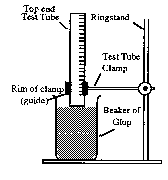Grade 5-8 Performance Task
Contributed by: New York State Education Department (NYSED)
NYS Alternative Assessment in Science Project (1996)
Task:
At this station, you will observe and analyze a
model of the interaction between the Earth's crust and upper mantle.
Materials:
- 1 250 ml beaker containing glop
- 1 timer
- 1 ring stand
- 1 test tube clamp
- 1 test tube with scale

Background:
Some geologists believe the theory that there is a
semi-fluid layer 100 to 300 kilometers below the Earth's surface.
Due to high temperature and pressure, the rock in this region behaves
both like a solid and a liquid. Slow movements in this region are
thought to be related to changes in the upper crust and to fractures
in the Earth's surface. The model in this activity may demonstrate
how these changes can occur.
Directions:
- Set up the equipment exactly as it appears in the diagram above.
- Before installing the test tube clamp on the ring stand, adjust
the opening of the clamp so that the test tube will slide easily
through it. **The clamp will not be used to hold the test tube,
but rather to guide its movement.**
- Place the test tube within the clamp and directly over the glop
in the beaker. Hold the test tube above the glop, but do not
allow it to rest on the glop yet.
- Turn the test tube so that the lines and numbers can be read
easily.
- Carefully hold the test tube so that it just touches the surface
of the glop. Using the bottom rim of the clamp as your guide,
make sure that the scale on the test tube reads zero.
- Release the test tube and start the timer.
- Read the level of the test tube to the nearest tenth of a centimeter
every half minute. For each reading, record the level using the
rim of the clamp as your guide (refer to above diagram). Take
readings for a maximum of 5 minutes.
- Record your observations regarding the level of the graduated
test tube in the table below. Make a line graph of your data using
time and change in level as your variables. Label both axes. Include
proper units.

- Assume that your data is an accurate model for the behavior
of a mountain range such as the Himalayas or the Adirondacks.
How would the rate of sinking of the mountains early in
their formation compare with the rate late in their development?
Answer in complete sentences.
- Based on your observations of this model, explain one possibility
why the crust is usually pushed deeper into the earth below old
mountains than under newly formed mountains. Answer in complete
sentences.
- List at least three factors in the natural world that have not
been accounted for in this model.
|



